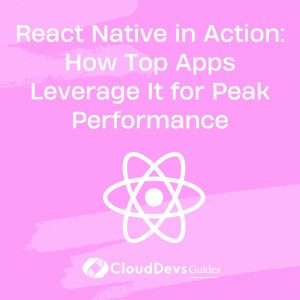React Native in Action: How Top Apps Leverage It for Peak Performance
React Native is an open-source mobile application framework developed by Facebook, enabling developers to use React and JavaScript to create applications for iOS and Android. Since its introduction in 2015, it has been extensively adopted by developers across the globe, and many companies choose to hire React Native developers due to the framework’s ease of use, efficiency, and robustness. In this post, we will delve into the power of React Native, exploring how hiring React Native developers can aid in the creation of high-performance mobile applications. We will also walk through a few real-world examples that exemplify its vast potential.
Understanding React Native
React Native leverages the popular JavaScript library, React, for building user interfaces, while also allowing developers to tap into the native capabilities of the target platform. This is a distinct advantage over traditional hybrid approaches that render code within a WebView. With React Native, the application’s UI is rendered using native views, resulting in improved performance and a more authentic feel.
The Power of React Native
Several characteristics make React Native a powerful tool for mobile app development:
- Cross-Platform Compatibility: React Native allows developers to maintain a single codebase for both iOS and Android platforms, significantly reducing the development and maintenance time.
- High Performance: Because React Native uses native components for rendering, the app’s performance is closer to a native app compared to traditional hybrid apps.
- Fast Refresh and Hot Reloading: These features allow developers to see the results of their code changes in real-time, without needing a full recompilation of the app, making the development process faster and more efficient.
- Strong Community Support: With a large and active community, there’s a wealth of third-party libraries available, as well as plenty of resources for troubleshooting and learning.
- Flexible Development: React Native supports both JavaScript and TypeScript, giving developers the flexibility to choose the one that best suits their project requirements.
Examples of High-Performance Apps Built with React Native
To further understand the power of React Native, let’s consider some successful high-performance applications built using this framework.
1. Facebook
React Native was initially developed by Facebook to address the challenges they faced with their mobile app development. Today, parts of the Facebook app, like the Ads Manager, are built using React Native. This has resulted in improved performance and consistency between the iOS and Android apps, as well as faster iteration cycles.
2. Instagram
Instagram, owned by Facebook, also adopted React Native for parts of their app. The “Push Notification” view, which was initially implemented as a WebView, was the first feature to be built with React Native. This significantly improved the feature’s speed, resulting in a more responsive and efficient user experience.
3. Skype
Microsoft moved Skype to React Native in 2017. The transition helped them overcome various issues, such as slow performance and inconsistency in the user interface between different platforms. With React Native, Skype’s performance was significantly improved, and developers were able to deliver a uniform user experience across all platforms.
4. Tesla
The mobile apps for Tesla cars are also built using React Native. The performance and smooth user interface of the Tesla app demonstrate the power and flexibility of React Native.
5. Bloomberg
Bloomberg’s consumer mobile application for iOS and Android offers users streamlined access to the company’s global business and finance news. By transitioning to React Native, the company was able to develop an app with impressive performance and an intuitive user interface.
These examples are proof that React Native is not only suitable for small-scale projects, but it can also handle large-scale, complex applications that require high performance and responsiveness.
Conclusion
React Native has affirmed its position in mobile app development by marrying the versatility of React and JavaScript with the performance of native applications. By hiring React Native developers, businesses can enjoy faster development cycles, consistent user experiences across platforms, and high-performance apps. This framework has been utilized by giants like Facebook, Instagram, Skype, and Tesla for their popular apps.
In the current scenario where the need for efficient, performant, cross-platform mobile apps is on the rise, React Native remains a preferred solution. Regardless of whether you’re an experienced developer or a business owner planning to launch a mobile app, React Native offers powerful capabilities to consider.
It’s important to choose technology based on project needs. Nonetheless, React Native presents itself as a strong contender for your next mobile app development project, especially when hiring React Native developers.
Table of Contents









